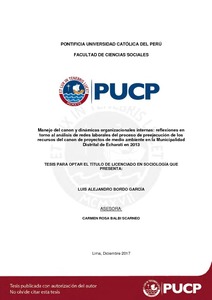| dc.contributor.advisor | Balbi Scarneo, Carmen Rosa | es_ES |
| dc.contributor.author | Bordo García, Luis Alejandro | |
| dc.date.accessioned | 2018-02-14T21:42:07Z | es_ES |
| dc.date.available | 2018-02-14T21:42:07Z | es_ES |
| dc.date.created | 2017 | es_ES |
| dc.date.issued | 2018-02-14 | es_ES |
| dc.identifier.uri | http://hdl.handle.net/20.500.12404/10148 | |
| dc.description.abstract | El tema del canon en el Perú ha sido estudiado generalmente enfocando los elementos normativos, logísticos o políticos que influyen en su manejo. El objetivo principal de esta investigación es el análisis de un elemento adicional no explorado: las dinámicas laborales entre los funcionarios implicados en el proceso de trabajo interno de manejo del canon, dentro de una organización que disponga de dichos recursos. El trabajo de campo de esta investigación fue de diez días en diciembre de 2012 y de seis semanas entre febrero y abril de 2013 en la Municipalidad Distrital de Echarati (La Convención, Cuzco), el gobierno local con mayor presupuesto en Perú en 2013, principalmente compuesto por el canon del gas natural de Camisea. Durante el trabajo de campo, visitamos diariamente las seis oficinas relacionadas a las etapas de planeamiento y diseño (preejecución) de los proyectos medioambientales financiados con los recursos del canon. La recolección y el análisis de la información se hicieron tomando los puntos de encuentro entre la teoría sociológica sobre organizaciones burocráticas y las herramientas del Análisis de Redes Sociales (ARS). Encontramos que el ARS permite observar sistemáticamente algunas de las disfunciones típicas de la burocracia, reflejadas en el aislamiento y tensiones entre las oficinas implicadas en la elaboración y revisión de los perfiles y expedientes técnicos de los proyectos de inversión medioambientales del canon. Adicionalmente, la perspectiva utilizada permitió proponer recomendaciones de gestión para mitigar las problemáticas observadas, orientadas a mejorar flujos de información interna y conocimiento del otro entre los funcionarios. Nuestros hallazgos y conclusiones fueron contextualizados en el marco de las tensiones entre el Bajo Urubamba, zona remota recientemente independizada como el distrito de Megantoni, donde se encuentra el gas de Camisea, y el Alto Urubamba, donde se encuentra el pueblo de Echarati y la mayoría de zonas urbanas. | es_ES |
| dc.description.abstract | In approaching the subject of royalties paid by extractive industries in Peru, authors have generally focused on normative, logistic or politic elements that influence its management. The main objective of this study is to analyze an additional element not explored: the labor dynamics of public workers involved in the internal processes of management of those royalties, inside an organization with said resources. The fieldwork for this research was conducted in ten days in December 2012 and six weeks between February and April 2013 in the Municipality of the District of Echarati (La Convención, Cuzco), the district municipality in Peru with the largest fiscal budget in 2013, mostly composed of the royalties from the extraction of Camisea natural gas.
During the fieldwork, we visited on a daily basis the six offices related to the stages of planning and design (pre-execution) of the environmental projects financed with the natural gas royalties. The gathering and the analysis of information were made considering the encounter points between the sociological theory on bureaucratic organizations and the tools of Social Networks Analysis (SNA). We found that SNA allows systematic observation of some of the typical dysfunctions of bureaucracy, reflected in the isolation and tensions between the offices implied in the elaboration and revision of the profiles and technical expedients of the environmental projects financed by the royalties. In addition, our perspective allowed us to propose management recommendations to mitigate the observed problems, oriented towards
improving internal flows of information and awareness among public workers. Our findings and conclusions are contextualized in the setting of tensions between the Bajo Urubamba, a remote area which recently became independent as the district of Megantoni, where the Camisea natural gas is found, and the Alto Urubamba, where the town of Echarati and most of the urban areas are located. | es_ES |
| dc.language.iso | spa | es_ES |
| dc.publisher | Pontificia Universidad Católica del Perú | es_ES |
| dc.rights | info:eu-repo/semantics/openAccess | es_ES |
| dc.rights.uri | http://creativecommons.org/licenses/by-nc-nd/2.5/pe/ | * |
| dc.subject | Gas de Camisea--Perú--Cuzco | es_ES |
| dc.subject | Recursos energéticos--Perú--Cuzco | es_ES |
| dc.subject | Medio ambiente--Perú--Cuzco | es_ES |
| dc.subject | Administración pública--Perú--Cuzco | es_ES |
| dc.title | Manejo del canon y dinámicas organizacionales internas: reflexiones en torno al análisis de redes laborales del proceso de preejecución de los recursos del canon de proyectos de medio ambiente en la Municipalidad Distrital de Echarati en 2013 | es_ES |
| dc.type | info:eu-repo/semantics/bachelorThesis | es_ES |
| thesis.degree.name | Licenciado en Sociología | es_ES |
| thesis.degree.level | Título Profesional | es_ES |
| thesis.degree.grantor | Pontificia Universidad Católica del Perú. Facultad de Ciencias Sociales | es_ES |
| thesis.degree.discipline | Sociología | es_ES |
| renati.discipline | 314086 | es_ES |
| renati.level | https://purl.org/pe-repo/renati/level#tituloProfesional | es_ES |
| renati.type | https://purl.org/pe-repo/renati/type#tesis | es_ES |
| dc.publisher.country | PE | es_ES |
| dc.subject.ocde | https://purl.org/pe-repo/ocde/ford#5.04.01 | es_ES |






